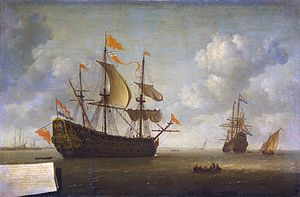Royal Charles

Royal Charles off Hellevoetsluis, captured by the Dutch after the Raid on the Medway, June 1667. Jeronymus van Diest (II).
|
|
| History | |
|---|---|
|
|
|
| Name: | Naseby |
| Ordered: | 3 July 1654 |
| Builder: | Peter Pett II, Woolwich Dockyard |
| Launched: | 12 April 1655 |
| Renamed: | Royal Charles, 23 May 1660 |
| Captured: | 12 June 1667, by the Dutch |
| Fate: | Sold for scrap, 1673 (by Dutch navy) |
| Notes: |
|
| General characteristics | |
| Class and type: | 80-gun first-rate ship of the line |
| Tons burthen: | 1129 (bm) on completion, later increased to 1258 17⁄94 bm |
| Length: | 131 ft (39.9 m) (keel) |
| Beam: | 42 ft 0 in (12.8 m) on completion, later increased to 42 ft 6 in (13.0 m) |
| Depth of hold: | 18 ft (5.5 m) |
| Sail plan: | Full-rigged ship |
| Complement: | 500 - later raised to 550 then 650 |
| Armament: | 80 guns of various weights of shot |
Royal Charles was an 80-gun first-rate three-decker ship of the line of the English Navy. She was originally called Naseby, built by Peter Pett, and launched at Woolwich Dockyard in 1655, for the navy of the Commonwealth of England, and named in honour of Sir Thomas Fairfax's decisive 1645 victory over the Royalist forces during the English Civil Wars. She was ordered in 1654 as one of a programme of four second rates, intended to carry 60 guns each. However, she was altered during construction to mount a complete battery of guns along the upper deck (compared with the partial battery on this deck of her intended sisters, on which there were no gunports in the waist along this deck), and so was reclassed as a first rate.
In the run-up to the Restoration of the monarchy during June 1660 she was anchored in The Downs off Deal, where her laurel-crowned figurehead of Oliver Cromwell was removed before sailing to the Dutch Republic at the head of the fleet sent to bring King Charles II back to England, captained by Sir Edward Montagu and still under her Parliamentary name. On arrival in Scheveningen she was renamed HMS Royal Charles and took Charles and his entourage (including Samuel Pepys) on board, landing them at Dover.
Under her new name, she thus joined the Royal Navy which formally came into being in 1660. At 1,229 tons, Naseby was larger than Sovereign of the Seas, the first three-deck ship of the line, built by Phineas Pett, Peter's father. Unlike Sovereign of the Seas, which was in service from 1637 to 1697, Naseby was to enjoy only twelve years in service.
...
Wikipedia
